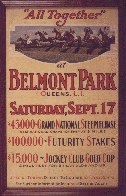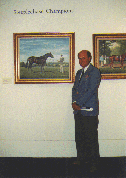The Sporting Horse: Steeplechase and the Thoroughbred
From the beginning of the breed, Thoroughbreds were intended for a narrowly defined purpose, that of racing over the flat. The modern Thoroughbred, though, has become increasingly versatile, succeeding in many different areas of sport. Show jumping and dressage have become Olympic level sports, taking advantage of the agility and grace of the Thoroughbred. The royal sport of polo, too, has benefited from the singular abilities of these horses. But it is the arduous work of the steeplechase, and of the hunt meeting, that has best, and most popularly, showcased the talents of the Thoroughbred outside flat racing.

A Steeplechase
This Fredrick Remington painting captures the energy and power of the jumping horse.
"Thorough-bred horses make the best hunters. I never
heard of a great thing yet but it was done by a thorough-bred horse (Longrigg,
156)." By the late eighteenth century, most mounts used
in English sporting hunts were Thoroughbreds. With their speed and agility,
Thoroughbreds were ideally suited for hunts over flat, rocky pasture. Gradually,
the speed of the horses began to dominate the hunt, as gentlemen owners
and riders tried desperately to outrun their neighbors and prove their horse
the fastest. In the 1790s, owners hired professional flat jockeys to ride
their hunting Thoroughbreds in cross country match races over fences and
hedges, and even the pretense of hounds and scents to follow had in general
been abandoned. An English Sporting Dictionary of 1803 defined a hunt match,
or steeplechase as it came to be called, as parties "rid[ing]
their own horses across country to some point agreed upon, encountering
all difficulties and taking the leaps in stroke (Longrigg, 156)."
The first steeplechase course set up on a race track was created with artificial barriers at Newmarket in 1794. Gradually, the idea of a laid out jump course caught on, and the sport of steeplechasing was organized; prize money was offered, betting opportunities abounded, and classic races, like the Grand National at Aintree in 1839, were created. Barriers designed to provide the most challenging events included stone walls, hedges, fences, and brooks.

Belmont Poster
An early twentieth century advertisement for the American Grand National Steeplechase at Belmont Park
Steeplechasing came to the United States after the Civil War. In 1869,
a steeplechase was held at Jerome Park in New York. "The
people pronounced it immense and it was an all-absorbing topic for weeks
(National Museum of Racing panel)." Jumping races were
soon arranged on race tracks across the country, making up a regular part
of many tracks' race meeting. An American Grand National was created to
rival the original English race, and was run at Belmont Park.

Maryland Hunt Cup Map/Far Hills Course Map
A hunt meeting for amateur riders, this course is made up of a grueling series of jumps and obstacles.
At the same time that steeplechasing was gaining popularity in the United
States, another trend was developing that would eventually threaten the
future of jumping at race tracks. Hunt meetings, similar to eighteenth century
English hunts, were being created for amateur riders. Cross-country matches
took place over open fields littered with natural barriers. Seen against
these increasingly grueling hunt meetings, professionally-ridden steeplechasing
came to be seen as the "poor cousin",
with smaller, tamer jumps, and few rewards. However, the National Steeplechase
and Hunt Association was formed in 1895 to regulate both of these sports
throughout the United States, and that organization, together with enthusiastic
and persistent owners, kept steeplechasing alive. Today, it has regained
popularity, and the twentieth century has seen several "stars"
of the 'chase emerge. Joe Aitcheson had won a record 440 steeplechase races
by the time he retired as a jockey in 1977. Jonathan Sheppard was named
the leading steeplechase trainer in the country in 1995; he has won that
title twenty-one times in the past twenty-six years. But it is the horses
who are perhaps best remembered. Sergeant Murphy was the first American-bred
horse to win the English Grand National, in 1923. Battleship, a chestnut
son of Man O' War, won both the American and the English Grand Nationals
in the 1930s.

Jonathan Sheppard
Named the leading steeplechase trainer in the country in 1995.
Conclusion
"Thoroughbred racing is always moving forward on a
line between here and perfection (Bowen, 18)." Every once
in a while, a horse appears on the racetrack that provides a glimpse of
what perfection is like: grace, beauty, energy, and heart. These gifts of
perfection ensure that the sport of racing will outlast even the most ardent
critic, and the hardest of economic times. Breeders and owners will never
tire of mixing bloodlines and genetic traits to find the one combination
that produces a Secretariat, or a Man O' War. Jockeys and trainers will
not be able to give up the exhilaration of coaxing twelve hundred pounds
of muscle around a track, or over a jump. And fans will always remain at
the rails, in their attempt to see a piece of history, or to witness the
birth of the next champion.

National Museum of Racing
The National Museum of Racing and Hall of Fame is located across the street from the historic Saratoga race track.